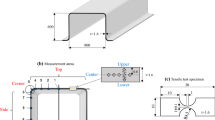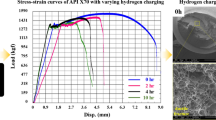Abstract
This paper studied the influence of hot rolling and annealing processes on the hydrogen embrittlement sensitivity of AISI 430 ferritic stainless steel and the changes in hydrogen-induced fracture modes through electrochemical hydrogen charging experiments. The tensile test results show that the hot-rolled specimen has the highest hydrogen embrittlement sensitivity, and the highest yield strength and tensile strength. After the heat treatment, the yield strength of all specimens was significantly increased after hydrogen charging, which was attributed to the hydrogen-induced dislocation pinning effect. The fracture morphology analysis revealed that the hot-rolled specimen was dominated by intergranular fracture, accompanied by cleavage fracture, predominantly by the hydrogen-enhanced decohesion (HEDE) mechanism, while the fracture modes of annealed specimen were cleavage fracture and quasi-cleavage fracture due to the hydrogen-enhanced localized plasticity (HELP) and hydrogen-enhanced decohesion (HEDE) mechanisms.









Similar content being viewed by others
References
S. Dutta, A Review on Production, Storage of Hydrogen and Its Utilization as an Energy Resource, J. Ind. Eng. Chem., 2014, 20(4), p 1148–1156.
X. Xing, R. Cheng, G. Cui, J. Liu, J. Gou, C. Yang, Z. Li and F. Yang, Quantification of the Temperature Threshold of Hydrogen Embrittlement in X90 Pipeline Steel, Mater. Sci. Eng. A, 2021, 800, p 140118.
C. Zhou, B. Ye, Y. Song, T. Cui, P. Xu and L. Zhang, Effects of Internal Hydrogen and Surface-Absorbed Hydrogen on the Hydrogen Embrittlement of X80 Pipeline Steel, Int. J. Hydrog. Energy, 2019, 44(40), p 22547–22558.
E. Ohaeri, J. Omale, K.M.M. Rahman and J. Szpunar, Effect of Post-processing Annealing Treatments on Microstructure Development and Hydrogen Embrittlement in API 5L X70 Pipeline Steel, Mater. Charact., 2020, 161, p 110124.
Q. Deng, W. Zhao, W. Jiang, T. Zhang, T. Li and Y. Zhao, Hydrogen Embrittlement Susceptibility and Safety Control of Reheated CGHAZ in X80 Welded Pipeline, J. Mater. Eng. Perform., 2018, 27(4), p 1654–1663.
X. Chen, L. Ma, C. Zhou, Y. Hong, H. Tao, J. Zheng and L. Zhang, Improved Resistance to Hydrogen Environment Embrittlement of Warm-Deformed 304 Austenitic Stainless Steel in High-pressure Hydrogen Atmosphere, Corros. Sci., 2019, 148, p 159–170.
I.M. Robertson, P. Sofronis, A. Nagao, M.L. Martin, S. Wang, D.W. Gross and K.E. Nygren, Hydrogen Embrittlement Understood, Metall. Mater. Trans. B, 2015, 46(3), p 1085–1103.
S. Wang, A. Nagao, P. Sofronis and I.M. Robertson, Assessment of the Impact of Hydrogen on the Stress Developed Ahead of a Fatigue Crack, Acta Mater., 2019, 174, p 181–188.
C. Zhou, Q. Huang, Q. Guo, J. Zheng, X. Chen, J. Zhu and L. Zhang, Sulphide Stress Cracking Behaviour of the Dissimilar Metal Welded Joint of X60 Pipeline Steel and Inconel 625 Alloy, Corros. Sci., 2016, 110, p 242–252.
A. Turk, G.R. Joshi, M. Gintalas, M. Callisti, P.E.J. Rivera-Díaz-del-Castillo and E.I. Galindo-Nava, Quantification of Hydrogen Trapping in Multiphase Steels: Part I-Point Traps in Martensite, Acta Mater., 2020, 194, p 118–133.
A. Turk, S.D. Pu, D. Bombač, P.E.J. Rivera-Díaz-del-Castillo and E.I. Galindo-Nava, Quantification of Hydrogen Trapping in Multiphase Steels: Part II–Effect of Austenite Morphology, Acta Mater., 2020, 197, p 253–268.
C.D. Beachem, A New Model for Hydrogen-Assisted Cracking (hydrogen “embrittlement”), Metall. Mater. Trans. B, 1972, 3(2), p 441–455.
A.R. Troiano, The Role of Hydrogen and Other Interstitials in the Mechanical Behavior of Metals, Trans. Am. Soc. Met., 1960, 52, p 54–80.
R.A. Oriani, Whitney Award Lecture-1987: Hydrogen-The Versatile Embrittler, Corrosion, 1987, 43(7), p 390–397.
I.M. Robertson, The Effect of Hydrogen on Dislocation Dynamics, Eng. Fract. Mech., 2001, 68(6), p 671–692.
M. Wasim, M.B. Djukic and T.D. Ngo, Influence of Hydrogen-Enhanced Plasticity and Decohesion Mechanisms of Hydrogen Embrittlement on the Fracture Resistance of Steel, Eng. Fail. Anal., 2021, 123, p 105312.
M.B. Djukic, G.M. Bakic, V.S. Zeravcic, A. Sedmak and B. Rajicic, The Synergistic Action and Interplay of Hydrogen Embrittlement Mechanisms in Steels and Iron: Localized Plasticity and Decohesion, Eng. Fract. Mech., 2019, 216, p 106528.
Y. Ogawa, D. Birenis, H. Matsunaga, O. Takakuwa, J. Yamabe, Ø. Prytz and A. Thøgersen, The Role of Intergranular Fracture on Hydrogen-Assisted Fatigue Crack Propagation in Pure Iron at a Low Stress Intensity Range, Mater. Sci. Eng. A, 2018, 733, p 316–328.
P. Novak, R. Yuan, B.P. Somerday, P. Sofronis and R.O. Ritchie, A Statistical, Physical-Based, Micro-mechanical Model of Hydrogen-Induced Intergranular Fracture in Steel, J. Mech. Phys. Solids, 2010, 58(2), p 206–226.
M. Koyama, C.C. Tasan, E. Akiyama, K. Tsuzaki and D. Raabe, Hydrogen-Assisted Decohesion and Localized Plasticity in Dual-phase Steel, Acta Mater., 2014, 70, p 174–187.
M. Jedrychowski, J. Tarasiuk, B. Bacroix and S. Wronski, Electron Backscatter Diffraction Investigation of Local Misorientations and Orientation Gradients in Connection with Evolution of Grain Boundary Structures in Deformed and Annealed Zirconium. A New Approach in Grain Boundary Analysis, J. Appl. Crystallogr., 2013, 753, p 93–96.
M. Calcagnotto, D. Ponge, E. Demir and D. Raabe, Orientation Gradients and Geometrically Necessary Dislocations in Ultrafine Grained Dual-phase Steels Studied by 2D and 3D EBSD, Mater. Sci. Eng. A, 2010, 527(10), p 2738–2746.
Q. Liu and N. Hansen, Geometrically Necessary Boundaries and Incidental Dislocation Boundaries Formed During Cold Deformation, Scr. Metall. Mater., 1995, 32(8), p 1289–1295.
J. Lufrano and P. Sofronis, Enhanced Hydrogen Concentrations Ahead of Rounded Notches and Cracks-Competition Between Plastic Strain and Hydrostatic Stress, Acta Mater., 1998, 46(5), p 1519–1526.
N. Bandyopadhyay, J. Kameda and C.J. McMahon, Hydrogen-Induced Cracking in 4340-type Steel: Effects of Composition, Yield Strength, and H2 Pressure, Metall. Trans. A, 1983, 14(4), p 881–888.
Y. Murakami, T. Kanezaki and Y. Mine, Hydrogen Effect against Hydrogen Embrittlement, Metall. Mater. Trans. A, 2010, 41(10), p 2548–2562.
I.H. Katzarov, D.L. Pashov and A.T. Paxton, Hydrogen Embrittlement I. Analysis of Hydrogen-Enhanced Localized Plasticity: Effect of Hydrogen on the Velocity of Screw Dislocations in α-Fe, Phys. Rev. Mater., 2017, 1(3), p 033602.
S. Taketomi, R. Matsumoto and S. Hagihara, Molecular Statics Simulation of the Effect of Hydrogen Concentration on 112 < 111 > Edge Dislocation Mobility in Alpha Iron, ISIJ Int., 2017, 57(11), p 2058–2064.
W.J. Qi, R.G. Song, X. Qi, H. Li, Z.X. Wang, C. Wang and J.R. Jin, Hydrogen Embrittlement Susceptibility and Hydrogen-Induced Additive Stress of 7050 Aluminum Alloy Under Various Aging States, J. Mater. Eng. Perform., 2015, 24(9), p 3343–3355.
M. Okayasu and T. Fujiwara, Effects of Microstructural Characteristics on the Hydrogen Embrittlement Characteristics of Austenitic, Ferritic, and γ–α Duplex Stainless Steels, Mater. Sci. Eng. A, 2021, 807, p 140851.
C.L. Lai, L.W. Tsay and C. Chen, Effect of Microstructure on Hydrogen Embrittlement of Various Stainless Steels, Mater. Sci. Eng. A, 2013, 584, p 14–20.
D. Zhou, T. Li, D. Huang, Y. Wu, Z. Huang, W. Xiao, Q. Wang and X. Wang, The Experiment Study to Assess the Impact of Hydrogen Blended Natural Gas on the Tensile Properties and Damage Mechanism of X80 Pipeline Steel, Int. J. Hydrog. Energy, 2021, 46(10), p 7402–7414.
E. Malitckii, Y. Yagodzinskyy, P. Lehto, H. Remes, J. Romu and H. Hänninen, Hydrogen Effects on Mechanical Properties of 18%Cr Ferritic Stainless Steel, Mater. Sci. Eng. A, 2017, 700, p 331–337.
M. Maxelon, A. Pundt, W. Pyckhout-Hintzen and R. Kirchheim, Small Angle Neutron Scattering of Hydrogen Segregation at Dislocations in Palladium, Scr. Mater., 2001, 44(5), p 817–822.
R. Kirchheim, Reducing Grain Boundary, Dislocation Line and Vacancy Formation Energies by Solute Segregation: II. Experimental Evidence and Consequences, Acta Mater., 2007, 55(15), p 5139–5148.
V.G. Gavriljuk, V.N. Shivanyuk and J. Foct, Diagnostic Experimental Results on the Hydrogen Embrittlement of Austenitic Steels, Acta Mater., 2003, 51(5), p 1293–1305.
V.G. Gavriljuk, V.N. Shivanyuk and B.D. Shanina, Change in the Electron Structure Caused by C, N and H Atoms in Iron and Its Effect on their Interaction with Dislocations, Acta Mater., 2005, 53(19), p 5017–5024.
S. Moriya, H. Matsui and H. Kimura, The Effect of Hydrogen on the Mechanical Properties of High Purity Iron II. Effect of Quenched-in Hydrogen Below Room Temperature, Mater. Sci. Eng., 1979, 40(2), p 217–225.
O. Di Pietro, G. Napoli, M. Gaggiotti, R. Marini, G. Stornelli and A. Schino, Analysis of Plastic Forming Parameters In Aisi 441 Stainless Steel, Acta Metall. Slovaca, 2020, 26, p 178–183.
M.L. Martin, M.J. Connolly, F.W. DelRio and A.J. Slifka, Hydrogen Embrittlement in Ferritic Steels, Appl. Phys. Rev., 2020, 7(4), p 041301.
S.S.M. Tavares, I.N. Bastos, J.M. Pardal, T.R. Montenegro and M.R. da Silva, Slow Strain Rate Tensile Test Results of New Multiphase 17%Cr Stainless Steel Under Hydrogen Cathodic Charging, Int. J. Hydrog. Energy, 2015, 40(47), p 16992–16999.
R. Kirchheim, Revisiting Hydrogen Embrittlement Models and Hydrogen-Induced Homogeneous Nucleation of Dislocations, Scr. Mater., 2010, 62(2), p 67–70.
X. Ren, Q. Zhou, W. Chu, J. Li, Y. Su and L. Qiao, The Mechanism of Nucleation of Hydrogen Blister in Metals, Chinese Sci. Bull., 2007, 52(14), p 2000–2005.
S. Wang, M.L. Martin, P. Sofronis, S. Ohnuki, N. Hashimoto and I.M. Robertson, Hydrogen-Induced Intergranular Failure of Iron, Acta Mater., 2014, 69, p 275–282.
M.L. Martin, J.A. Fenske, G.S. Liu, P. Sofronis and I.M. Robertson, On the Formation and Nature of Quasi-Cleavage Fracture Surfaces in Hydrogen Embrittled Steels, Acta Mater., 2011, 59(4), p 1601–1606.
A. Nagao, C.D. Smith, M. Dadfarnia, P. Sofronis and I.M. Robertson, The Role of Hydrogen in Hydrogen Embrittlement Fracture of Lath Martensitic Steel, Acta Mater., 2012, 60(13), p 5182–5189.
Acknowledgments
The authors wish to acknowledge the financial support of the Shanxi International Cooperation Project (Approval Number: 201603D421026).
Author information
Authors and Affiliations
Corresponding author
Additional information
Publisher's Note
Springer Nature remains neutral with regard to jurisdictional claims in published maps and institutional affiliations.
Rights and permissions
About this article
Cite this article
Wang, T., Lv, W., Xiao, W. et al. Investigation on Hydrogen Embrittlement Sensitivity of Hot-Rolled and Annealed Microstructure to AISI 430 Ferritic Stainless Steel. J. of Materi Eng and Perform 31, 1728–1736 (2022). https://doi.org/10.1007/s11665-021-06332-9
Received:
Revised:
Accepted:
Published:
Issue Date:
DOI: https://doi.org/10.1007/s11665-021-06332-9




